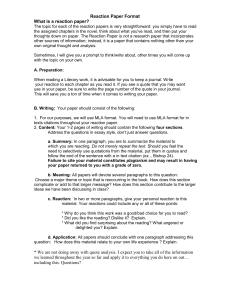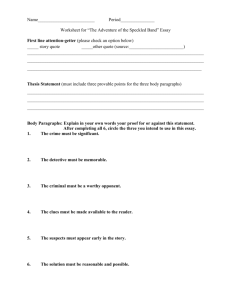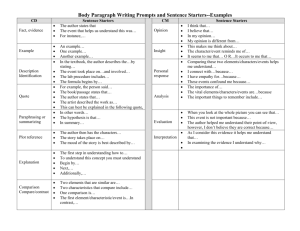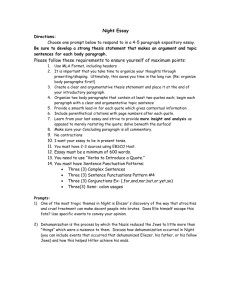About a Boy Mini-Essay Assignment
advertisement
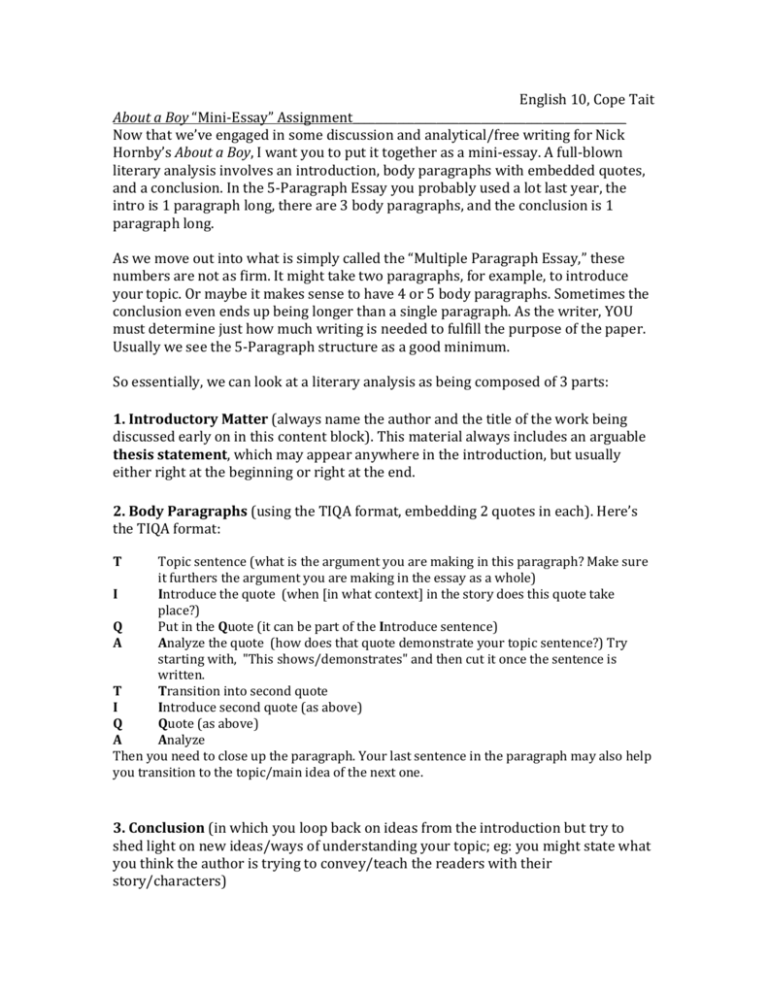
English 10, Cope Tait About a Boy “Mini-Essay” Assignment_________________________________________________ Now that we’ve engaged in some discussion and analytical/free writing for Nick Hornby’s About a Boy, I want you to put it together as a mini-essay. A full-blown literary analysis involves an introduction, body paragraphs with embedded quotes, and a conclusion. In the 5-Paragraph Essay you probably used a lot last year, the intro is 1 paragraph long, there are 3 body paragraphs, and the conclusion is 1 paragraph long. As we move out into what is simply called the “Multiple Paragraph Essay,” these numbers are not as firm. It might take two paragraphs, for example, to introduce your topic. Or maybe it makes sense to have 4 or 5 body paragraphs. Sometimes the conclusion even ends up being longer than a single paragraph. As the writer, YOU must determine just how much writing is needed to fulfill the purpose of the paper. Usually we see the 5-Paragraph structure as a good minimum. So essentially, we can look at a literary analysis as being composed of 3 parts: 1. Introductory Matter (always name the author and the title of the work being discussed early on in this content block). This material always includes an arguable thesis statement, which may appear anywhere in the introduction, but usually either right at the beginning or right at the end. 2. Body Paragraphs (using the TIQA format, embedding 2 quotes in each). Here’s the TIQA format: T Topic sentence (what is the argument you are making in this paragraph? Make sure it furthers the argument you are making in the essay as a whole) I Introduce the quote (when [in what context] in the story does this quote take place?) Q Put in the Quote (it can be part of the Introduce sentence) A Analyze the quote (how does that quote demonstrate your topic sentence?) Try starting with, "This shows/demonstrates" and then cut it once the sentence is written. T Transition into second quote I Introduce second quote (as above) Q Quote (as above) A Analyze Then you need to close up the paragraph. Your last sentence in the paragraph may also help you transition to the topic/main idea of the next one. 3. Conclusion (in which you loop back on ideas from the introduction but try to shed light on new ideas/ways of understanding your topic; eg: you might state what you think the author is trying to convey/teach the readers with their story/characters) For this assignment, we will still include all 3 parts, but they will be “mini.” This may seem easier than a full-length essay at first, but in some ways it’s harder, because you must be VERY efficient and precise with your language. There’s a very specific structure I want you to follow for this assignment, though I won’t always be so contolling! Here’s how it will look: 1. Introductory Matter: Two sentences, the first of which will include the author’s name and the title of the book, as well as your presentation of an important simile or metaphor from the book. The second sentence will be a firm, arguable statement that shows how that simile or metaphor encapsulates an important message Hornby is conveying through his characters and their stories. 2. Body Paragraphs (2): a. Body Paragraph 1: Using the TIQA format and embedding two relevant quotes—don’t forget page numbers—you will write one paragraph that elucidates the simile or metaphor you have chosen to discuss and relates it to the novel as a whole. b. Body Paragraph 2: Again using the TIQA format, relate the simile/metaphor you just discussed to what you have already claimed is an important “message” that Hornby is trying to convey. Your quotes for this one may come from those same passages that include the simile/metaphor, but they may also come from elsewhere in the book (like from the end, where Hornby comments on where everybody sort of lands). 3. Conclusion: One to two sentences in which you wrap up your discussion and make a judgment about Hornby’s “message” as identified in your introduction. Here might be a good place to incorporate an additional concept or quote (like the Kierkegaard quote, for example). Please complete this assignment for Friday. Should you choose to change topics entirely, that’s okay. This is all part of the process. Sometimes it takes pursuing one idea to land on another. No early part of the process is a waste. According to MLA (Modern Language Association) format, your mini-essay must be typed, double-spaced in 12-pt. Times New Roman font. Please use a Google document for this and all other formal assignments. Also according to MLA requirements, you should head your essay as follows. Top of page and against the left margin: Your Name Instructor’s Name (Cope Tait) Class Name (English 10) Date Title Notice that you must skip one line and then enter an original title (not the title of the assignment). This should be centered. Submitting this assignment: I have invited each of you (by email) to join our “Google Classroom,” which is called English 10, Cope Tait. Please follow the instructions to join the Classroom. There you will see that there is a folder for the “About a Boy Mini-Essay” assignment; this is where you need to put your document. Again, it is due Friday September 11th.
